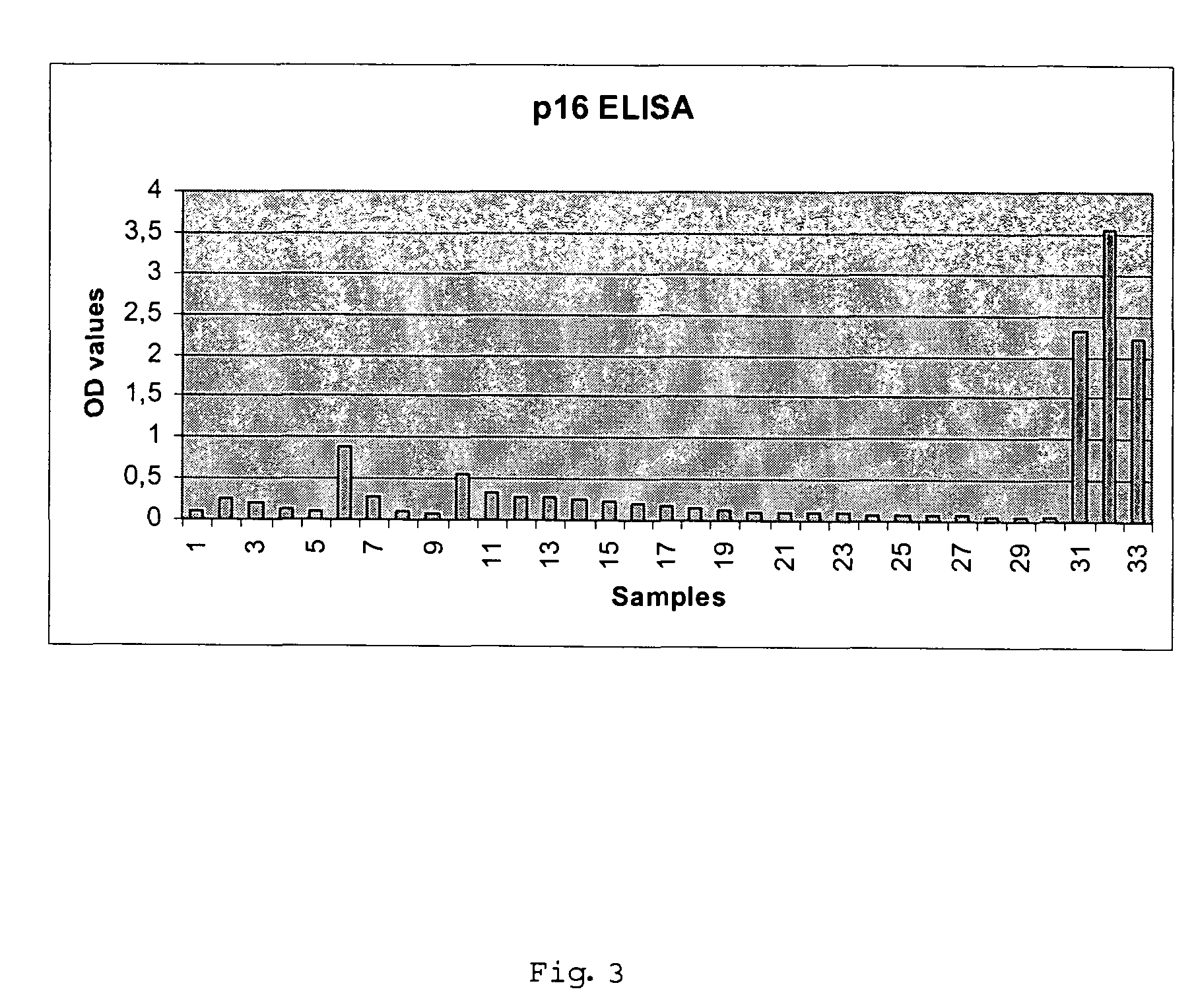Method for detecting carcinomas in a solubilized cervical body sample
a solubilized and cervical body technology, applied in the field of early diagnosis of carcinoma, can solve the problems of high inter- and intra-observer variance of experienced examiners, unsatisfactory false positive and false negative results of screening tests, and difficulty in preserving and preparing samples,
- Summary
- Abstract
- Description
- Claims
- Application Information
AI Technical Summary
Benefits of technology
Problems solved by technology
Method used
Image
Examples
example 1
Detection of the Overexpression of p16 in Biopsies of the Cervix Uteri
[0086](A) Paraffin sections having a thickness of 3 to 5 μm were produced from 20 biopsies of the cervix uteri, which comprised all degrees of the dysplastic progression from normal tissue (n=2) via CIN I (n=4), II (n=4), III (n=5) lesions to the invasive carcinoma (n=5). They were deparaffinized in xylene for 2×10 min. and rehydrogenated using ethanol. The antigens were demasked in 10 mM citrate buffer (pH 6.0) in an autoclave at 110° C. for 10 min. Thereafter, the endogenous peroxidases were inactivated using 0.25% H2O2 in PBS. Following the blocking of unspecific binding sites with horse serum (Vectastain ABC detection kit, Vector Laboratories, Burlingame, Calif.) at room temperature for 20 minutes, the sections were incubated with a p16-specific monoclonal antibody (Neomarkers, Fremont, Calif.) in the presence of 3% fetal calf serum at room temperature for 45 min. For the detection of the p16-antibody binding,...
example 2
Detection of the Overexpression of Cell Cycle Regulatory Proteins in HPV-transformed Cells
[0094](A) Cervical carcinoma cells CaSki which had been transformed with HPV16 were cultured in the absence of serum for 72 h. Following the addition of serum, cell extracts were collected at various times, subjected to SDS-PAGE and transferred to PVDF membranes (Du Pont). The expression of cdk4 was determined using polyclonal antiserum (1:1000) from Santa Cruz. Furthermore, the expression of HPV16-E7 protein was determined with a monoclonal antibody against HPV16-E7 (1:50) from Triton. The individual immune responses were detected via peroxidase-linked second antibodies and a chemiluminescence detection system (NEN, Du Pont).[0095]FIG. 1 shows that cdk4 was overexpressed.[0096](B) NIH3T3 cells were transformed with HPV16 so as to obtain an expression of HPV16-E7 protein. Cell extracts of the transformed cells were obtained and treated as described in (A). For detecting the expression of cdk6 a...
example 3
Detection of Cervical Intraepithelial Neoplasia in an ELISA Test Format
[0098]33 cervical swabs provided in a lysis buffer were subjected to ELISA based detection of overexpression of cyclin dependent kinase inhibitor p16 in solutions prepared from the cells contained in the swabs. The ELISA testing was performed as follows:
[0099]Cervical swab brushes were given into 15 ml vessels, containing 2 ml of mtm lysis buffer (2% TRITON® X-100, 0.4% SDS, 0.6 mM PMSF in PBS). Cervical cells present in the brush were lysed for at least 20 h. The lysates of the cervical swab samples were then transferred in 2 ml tubes and were centrifuged at 4° C. (15 min at 28.000×g (16.600 rpm HighspeedCentrifuge JEC Multi RF)); Supernatant was transferred to a fresh tube. The supernatant may be stored at −20° C.
(B) Performing the ELISA
[0100]Coating of ELISA-plates[0101]Stock-solution of p16 specific antibody clone mtm E6H4 was diluted in PBS to give ready-to-use coating solution.[0102]50 μl of t...
PUM
| Property | Measurement | Unit |
|---|---|---|
| pH | aaaaa | aaaaa |
| concentrations | aaaaa | aaaaa |
| concentrations | aaaaa | aaaaa |
Abstract
Description
Claims
Application Information
 Login to View More
Login to View More - R&D
- Intellectual Property
- Life Sciences
- Materials
- Tech Scout
- Unparalleled Data Quality
- Higher Quality Content
- 60% Fewer Hallucinations
Browse by: Latest US Patents, China's latest patents, Technical Efficacy Thesaurus, Application Domain, Technology Topic, Popular Technical Reports.
© 2025 PatSnap. All rights reserved.Legal|Privacy policy|Modern Slavery Act Transparency Statement|Sitemap|About US| Contact US: help@patsnap.com



